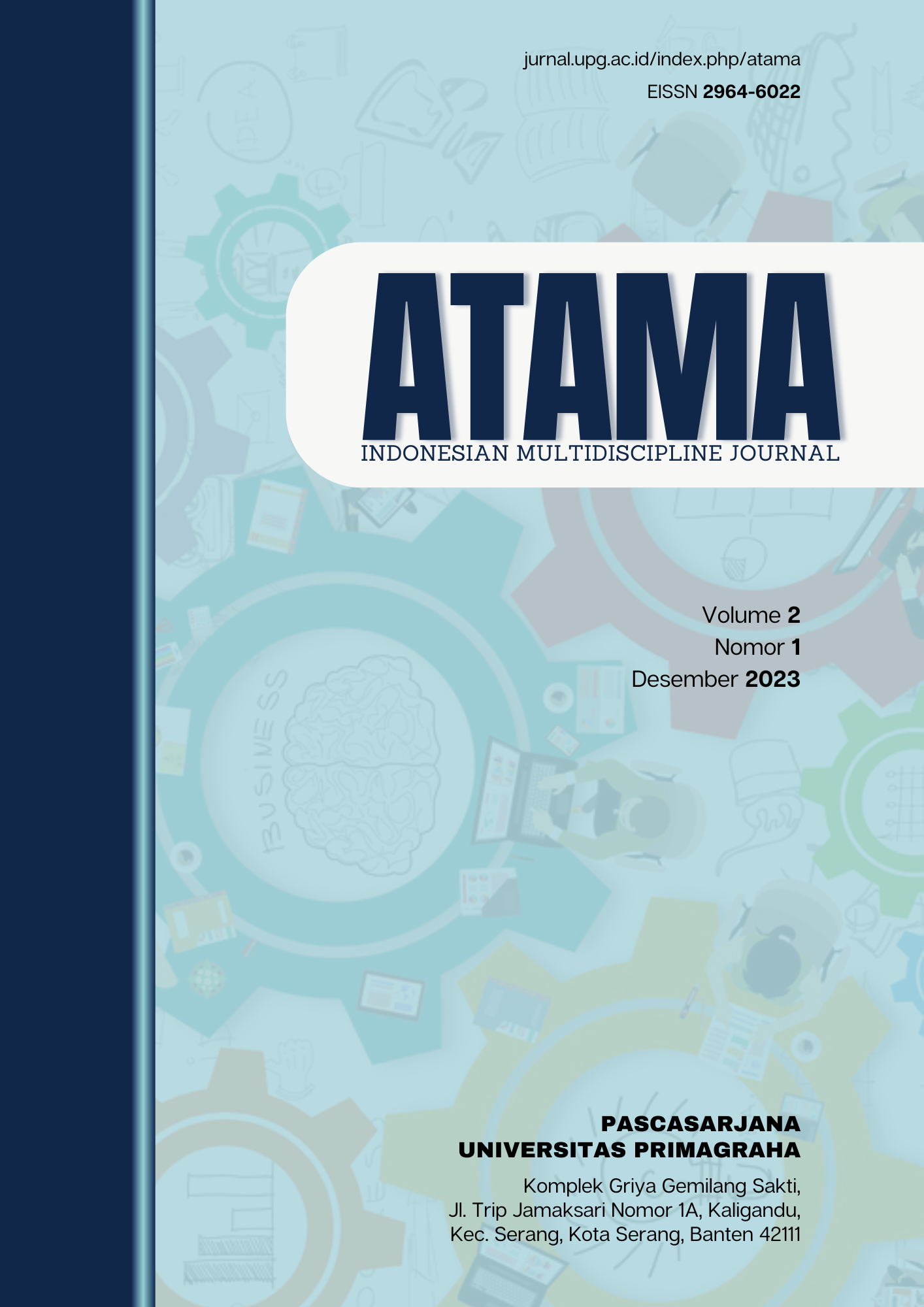The Influence of Career Paths and Incentives on Employee Performance at The Gunung Putri District Office, Bogor Regency
DOI:
https://doi.org/10.59605/atama.v2i1.733Keywords:
Incentives, Career Paths, Employee PerformanceAbstract
Human resources, especially in the government sector, are vital for realizing good governance. To realize good governance, it is essential to incentives attention to employee performance. This research aims to analyze employee performance regarding incentives and career paths. The method used in this research is a quantitative method with a PLS-SEM-based causality approach, which is analyzed using the SmartPLS software tool. The sample used in this research was 35 employees. The results of this research answer entirely the proposed hypothesis, where it is partially tested that incentives and career paths can influence employee performance. Career paths also have a positive and significant impact on incentives. Likewise, incentives can mediate between career paths and employee performance positively and significantly.
References
Ali, Z., Mahmood, B., & Mehreen, A. (2019). Linking succession planning to employee performance: The mediating roles of career development and performance appraisal. Australian Journal of Career Development, 28(2), 112–121. https://doi.org/10.1177/1038416219830419
Chen, T., Hao, S., Ding, K., Feng, X., Li, G., & Liang, X. (2020). The impact of organizational support on employee performance. Employee Relations: The International Journal, 42(1), 166–179. https://doi.org/10.1108/ER-01-2019-0079
Coccia, M. (2019). Intrinsic and Extrinsic Incentives to Support Motivation and Performance of Public Organizations. Journal of Economics Bibliography, 6(1), 20–29. https://doi.org/10.1453/jeb.v6i1.1795
Cook, K. S., & Hahn, M. (2021). Social Exchange Theory. In Theoretical Sociology (pp. 179–205). Routledge. https://doi.org/10.4324/9781003141372-14
Dutta, D., Kumar, K. K., & Mishra, S. K. (2021). Unintended consequences of promotions: Importance of annual incentives for performance management systems. Human Resource Management, 60(5), 787–801. https://doi.org/10.1002/hrm.22062
Grabner, I., & Martin, M. A. (2021). The effect of horizontal pay dispersion on the effectiveness of performance-based incentives. Accounting, Organizations and Society, 88, 101174. https://doi.org/10.1016/j.aos.2020.101174
Griffin, R. W., Phillips, J. M., & Gully, S. M. (2020). Organizational behavior: Managing people and organizations. CENGAGE learning.
Hair, J. F., Hult, G. T. M., Ringle, C. M., & Sarstedt, M. (2017). A Primer on Partial Least Squares Structural Equation Modeling (PLS-SEM) (2nd ed.). SAGE Publications.
Hair, J. F., Risher, J. J., Sarstedt, M., & Ringle, C. M. (2019). When to use and how to report the results of PLS-SEM. European Business Review, 31(1), 2–24. https://doi.org/10.1108/EBR-11-2018-0203
Hendri, M. I. (2019). The mediation effect of job satisfaction and organizational commitment on the organizational learning effect of the employee performance. International Journal of Productivity and Performance Management, 68(7), 1208–1234. https://doi.org/10.1108/IJPPM-05-2018-0174
Jegatheeswari, P., & Anandi, D. (2023). A Study on the Effect of Incentives on Employees Performance. SJCC Management Research Review, 13(1), 143–153. https://doi.org/10.35737/sjccmrr/V13/i1/2023/188
Lee, H.-W. (2019). Moderators of the Motivational Effects of Performance Management: A Comprehensive Exploration Based on Expectancy Theory. Public Personnel Management, 48(1), 27–55. https://doi.org/10.1177/0091026018783003
Lee, Y. L. A., Malik, A., Rosenberger III, P. J., & Sharma, P. (2020). Demystifying the differences in the impact of training and incentives on employee performance: mediating roles of trust and knowledge sharing. Journal of Knowledge Management, 24(8), 1987–2006. https://doi.org/10.1108/JKM-04-2020-0309
Legate, A. E., Hair, J. F., Chretien, J. L., & Risher, J. J. (2023). PLS-SEM: Prediction-oriented solutions for HRD researchers. Human Resource Development Quarterly, 34(1), 91–109. https://doi.org/10.1002/hrdq.21466
Locke, E. A., & Latham, G. P. (2019). The development of goal setting theory: A half century retrospective. Motivation Science, 5(2), 93–105. https://doi.org/10.1037/mot0000127
Mahmood, S., Hamid, K. bin A., & Badlishah, S. bin. (2021). The effect of human resource management practices on employee performance. Turkish Journal of Computer and Mathematics Education (TURCOMAT), 12(3), 2900–2911.
Manzoor, F., Wei, L., & Asif, M. (2021). Intrinsic Rewards and Employee’s Performance With the Mediating Mechanism of Employee’s Motivation. Frontiers in Psychology, 12. https://doi.org/10.3389/fpsyg.2021.563070
McLeod, J., Jenkin, A., Walters, G., & Irving, R. (2021). The role and performance of supporter directors: A social exchange theory perspective. Sport Management Review, 24(5), 862–885. https://doi.org/10.1080/14413523.2021.1880744
Mitchell, T. R. (2021). Expectancy-Value Models in Organizational Psychology. In Expectations and Actions (pp. 293–312). Routledge. https://doi.org/10.4324/9781003150879-16
Roberts, J. A., & David, M. E. (2020). Boss phubbing, trust, job satisfaction and employee performance. Personality and Individual Differences, 155, 109702. https://doi.org/10.1016/j.paid.2019.109702
Rodríguez-Sánchez, J.-L., González-Torres, T., Montero-Navarro, A., & Gallego-Losada, R. (2020). Investing Time and Resources for Work–Life Balance: The Effect on Talent Retention. International Journal of Environmental Research and Public Health, 17(6), 1920. https://doi.org/10.3390/ijerph17061920
Saeed, B. Bin, Afsar, B., Hafeez, S., Khan, I., Tahir, M., & Afridi, M. A. (2019). Promoting employee’s proenvironmental behavior through green human resource management practices. Corporate Social Responsibility and Environmental Management, 26(2), 424–438. https://doi.org/10.1002/csr.1694
Savickas, M. L. (2013). Career construction theory and practice. Career Development and Counseling: Putting Theory and Research to Work, 2, 144–180.
Viray, J. R. (2018). HRM Models in Public Sector Prior to Digital Tech Boom. KnE Social Sciences, 3(6), 1211. https://doi.org/10.18502/kss.v3i6.2533
Downloads
Published
Issue
Section
License
Copyright (c) 2023 Hery Julianto

This work is licensed under a Creative Commons Attribution-ShareAlike 4.0 International License.





